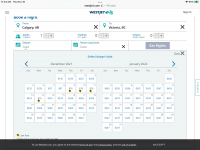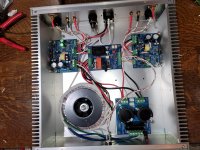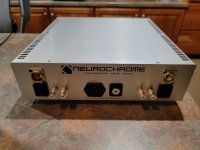It can be necessary to have the live and neutral connected in a specific way in some situations. But a transformer primary is really just a length of wire twirled around an iron core. It's a completely symmetric device. That's why you can swap live and neutral.
That said, if you live in a country that uses polarized mains plugs, I would connect the live to live and neutral to neutral. Just because.
Tom
That said, if you live in a country that uses polarized mains plugs, I would connect the live to live and neutral to neutral. Just because.
Tom
Fact is that if you hand-solder a stack of SMD boards, you will get considerable board-to-board variation in performance.
Hi Tom, do you know the cause(s) of this variation? I can't imagine why there'd be much variance as long as you don't damage the parts during soldering.
No. I haven't run the scientifically controlled experiment and statistical analysis to determine the root cause. But it's well known that soldering imposes stress on the components. Similarly, it's well established that stress can cause all sorts of variation in the performance. For example, package stress is one of the main contributors to variation in offset voltage in an opamp. In precision opamps the die is often coated with a stress-relief coating in order to minimize the impact of the package stress. I dealt with that quite a bit when I worked in the Precision Amplifiers Group at National Semiconductor.
Hand-soldering is likely the worst for stress as the part is heated up asymmetrically. Even if you use a toaster oven, hot plate, or hot air tool, you'll be heating the parts up unevenly.
By contrast, boards assembled by machine show consistent performance from board to board. Sure, there's variability, but it's much lower and, more importantly, the "weird outliers" (i.e., boards that work okayish but perform considerably worse than the rest of the bunch) are gone.
Tom
Hand-soldering is likely the worst for stress as the part is heated up asymmetrically. Even if you use a toaster oven, hot plate, or hot air tool, you'll be heating the parts up unevenly.
By contrast, boards assembled by machine show consistent performance from board to board. Sure, there's variability, but it's much lower and, more importantly, the "weird outliers" (i.e., boards that work okayish but perform considerably worse than the rest of the bunch) are gone.
Tom
Thanks, I wasn't aware that op amps can be so sensitive to package stress. The passives I've hand soldered and then measured have stayed well within tolerance (even after multiple solder/desolder cycles), but I've only measured a few.
After a rather stupid moment which Tom clarified I finished the cabling and the test of the power-86 as well as the DC offset test. With my old multimeter it goes down to 0.00V after a few seconds. The power-86 takes quite some time to go below +-5V after cutting the power.
Next step is to find a way to feed the test signal of 100mV and measure the output.
![IMG_20211114_005749[1].jpg IMG_20211114_005749[1].jpg](https://www.diyaudio.com/community/data/attachments/901/901421-88f3e6938956af21afc8a69e16f9272d.jpg?hash=iPPmk4lWry)
Next step is to find a way to feed the test signal of 100mV and measure the output.
![IMG_20211114_005749[1].jpg IMG_20211114_005749[1].jpg](https://www.diyaudio.com/community/data/attachments/901/901421-88f3e6938956af21afc8a69e16f9272d.jpg?hash=iPPmk4lWry)
The passives I've hand soldered and then measured have stayed well within tolerance (even after multiple solder/desolder cycles), but I've only measured a few.
I've had passives develop cracks due to soldering. They were fine when they came off the tape. They looked fine after soldering. But they didn't work and crumbled when removed with hot tweezers.
Not all damage is that dramatic. It wouldn't take much damage to cause "weird stuff" like "high" THD. Note that "high" in my case may be -110 dBc. The component value may not shift, but maybe its voltage coefficient did.
Tom
Yeah, I've heard of components cracking (MLCCs, especially) due to stresses from hand soldering, but I haven't had it happen to me (yet... that I know of 🙂).
Tom, a bit OT, but any impact in Calgary from the weather system that smacked us the last couple of days?
Not at all, really. We had two days of wind, light slush, and general misery. Now we're back to clear blue sky and about freezing. But with Vancouver cut off from the rest of Canada I'll have to get a bit creative if I want to visit you on the Island anytime soon. Hope you guys are OK.
Tom
Tom
Just for fun, I checked out WestJet schedule / rates for Calgary- Victoria direct. Look at the crazy prices during the first two week of December; you’d need to be creative about timing things for the return leg, though.
Attachments
Yeah... I'd imagine gas prices in the Lower Mainland would be skyrocketing as well.
To nudge the thread back on topic: I just ordered 40 LM3886TF directly from TI. I'll be making them available in pairs along with a pair of Modulus-86 boards. I will only be selling them with Modulus (or LM3886DR) boards. No direct sales.
Tom
To nudge the thread back on topic: I just ordered 40 LM3886TF directly from TI. I'll be making them available in pairs along with a pair of Modulus-86 boards. I will only be selling them with Modulus (or LM3886DR) boards. No direct sales.
Tom
Hello Tom,
are there any alternatives for the power LED on the power-86? A slightly brighter one in white, blue or green would be nice.
Cheers
Stefan
are there any alternatives for the power LED on the power-86? A slightly brighter one in white, blue or green would be nice.
Cheers
Stefan
New Mod 86 build from a newbie
Hello, I'm new to this site but spend quite a bit of time over on Audiocircle. I ran across a post from mkrawcz over there discussing how good some of the chip amps were. I was considering the Folsom 7293, but felt that the documentation was probably a little too spartan for someone with limited electronics knowledge to complete. Mkrawcz encouraged me to try the Neurochrome Mod 86 v3 - so I did!
Tom over at Neurochrome was fantastic to deal with. I probably exchanged around 30 emails with him from start to finish regarding what I needed to order, where to get substitute parts, and a few questions on the build itself. He was very patient with me and I was able to complete this build having very little electronics knowledge and not a huge understanding of how the amp actually works.
The chassis he sells is very high quality and looks nice as well as provides for a very tidy build. The sound of this little amp is fantastic!! I'm using it on some GR Research NX-Treme's and it sounds every bit as good (if not better) than the $4600 Primaluna Evo 300 that I also have.
Thanks Tom and mkrawcz for your help and I'd encourage anyone to give it a try if you're looking for a fun build and excellent sound.
Hello, I'm new to this site but spend quite a bit of time over on Audiocircle. I ran across a post from mkrawcz over there discussing how good some of the chip amps were. I was considering the Folsom 7293, but felt that the documentation was probably a little too spartan for someone with limited electronics knowledge to complete. Mkrawcz encouraged me to try the Neurochrome Mod 86 v3 - so I did!
Tom over at Neurochrome was fantastic to deal with. I probably exchanged around 30 emails with him from start to finish regarding what I needed to order, where to get substitute parts, and a few questions on the build itself. He was very patient with me and I was able to complete this build having very little electronics knowledge and not a huge understanding of how the amp actually works.
The chassis he sells is very high quality and looks nice as well as provides for a very tidy build. The sound of this little amp is fantastic!! I'm using it on some GR Research NX-Treme's and it sounds every bit as good (if not better) than the $4600 Primaluna Evo 300 that I also have.
Thanks Tom and mkrawcz for your help and I'd encourage anyone to give it a try if you're looking for a fun build and excellent sound.
Attachments
I think this is the first documented Modulus-86 Rev. 3.0 build. Nice work. Thank you for sharing.
Personally I would have put the power switch on the bottom, but I guess it's up to you. 🙂
I will have these chassis listed on my website before too long (hopefully). I'd probably sell more if I actually had them listed.
Tom
Personally I would have put the power switch on the bottom, but I guess it's up to you. 🙂
I will have these chassis listed on my website before too long (hopefully). I'd probably sell more if I actually had them listed.
Tom
Thanks again for all your help with this Tom. It was a fantastic experience from start to finish building this amp. I have a relative who likes it enough that he is considering going with the 286 or 686.
I don't spend much time on this forum as I said - so I had no idea this was the first documented build. I saw there were 574 pages and I assumed there were dozens if not more already documented. Must be previous versions.
Since this must be one of the first ones built with the new revision I guess I'll say a little bit more about the sound. The amp sounds really fantastic. I compared it to the PrimaLuna Evo 300 and also a Lyngdorf TDAI-2170. The Mod86 doesn't have the "warmth" of the PL - but it is very natural sounding. It is also cleaner, tighter, and faster than the PL with a dead silent background. For the most part I would say that I prefer vocals and string instruments on the PL and for everything else I prefer the Mod86.
The Lyngdorf has always been one of my favorite pieces of gear, but for whatever reason it just doesn't speak to me with the new NX-Treme speakers. I was pretty startled to find that I preferred the sound of the Mod86 over the Lyngdorf in every way. Not by a huge margin, but enough to be noticeable.
I have a Doge 8 tube preamp arriving tomorrow and I plan to pair that with the Mod86 to see how much that tweaks the sound.
Tom - one suggestion I would have if you ever make a revision on the chassis design - I would separate the binding posts a little more - they are very close together. I actually had a bit of a scare when I was breaking in the amp - I came downstairs and nothing was playing from the right channel. I checked and the weight of my speaker cable had rotated the spades enough that they were touching. I fixed the cables, turned it off and back on - still nothing. I unplugged it, opened up the case and couldn't see anything that looked fried, so I hooked it back up and miraculously it worked and has been ever since. A further separation of the binding posts of even 6mm or so would have prevented that from happening. Now I'm more careful with it and plan to switch to the SpeakOn connectors when I have a chance to terminate some new cables.
I don't spend much time on this forum as I said - so I had no idea this was the first documented build. I saw there were 574 pages and I assumed there were dozens if not more already documented. Must be previous versions.
Since this must be one of the first ones built with the new revision I guess I'll say a little bit more about the sound. The amp sounds really fantastic. I compared it to the PrimaLuna Evo 300 and also a Lyngdorf TDAI-2170. The Mod86 doesn't have the "warmth" of the PL - but it is very natural sounding. It is also cleaner, tighter, and faster than the PL with a dead silent background. For the most part I would say that I prefer vocals and string instruments on the PL and for everything else I prefer the Mod86.
The Lyngdorf has always been one of my favorite pieces of gear, but for whatever reason it just doesn't speak to me with the new NX-Treme speakers. I was pretty startled to find that I preferred the sound of the Mod86 over the Lyngdorf in every way. Not by a huge margin, but enough to be noticeable.
I have a Doge 8 tube preamp arriving tomorrow and I plan to pair that with the Mod86 to see how much that tweaks the sound.
Tom - one suggestion I would have if you ever make a revision on the chassis design - I would separate the binding posts a little more - they are very close together. I actually had a bit of a scare when I was breaking in the amp - I came downstairs and nothing was playing from the right channel. I checked and the weight of my speaker cable had rotated the spades enough that they were touching. I fixed the cables, turned it off and back on - still nothing. I unplugged it, opened up the case and couldn't see anything that looked fried, so I hooked it back up and miraculously it worked and has been ever since. A further separation of the binding posts of even 6mm or so would have prevented that from happening. Now I'm more careful with it and plan to switch to the SpeakOn connectors when I have a chance to terminate some new cables.
The case looks really nice. Is that a Takachi?I will have these chassis listed on my website before too long (hopefully). I'd probably sell more if I actually had them listed.
Tom
"I would separate the binding posts a little more"
Are they not the industry standard of 3/4" to fit banana plugs?
Are they not the industry standard of 3/4" to fit banana plugs?
...Personally I would have put the power switch on the bottom, ...
I feel the same way and that would be easy to do: loosen the front panel and turn it 180°. The PWR-SW is on the bottom.
If you don't like it - back to the previous version. 😉
- Home
- Amplifiers
- Chip Amps
- Modulus-86 build thread




